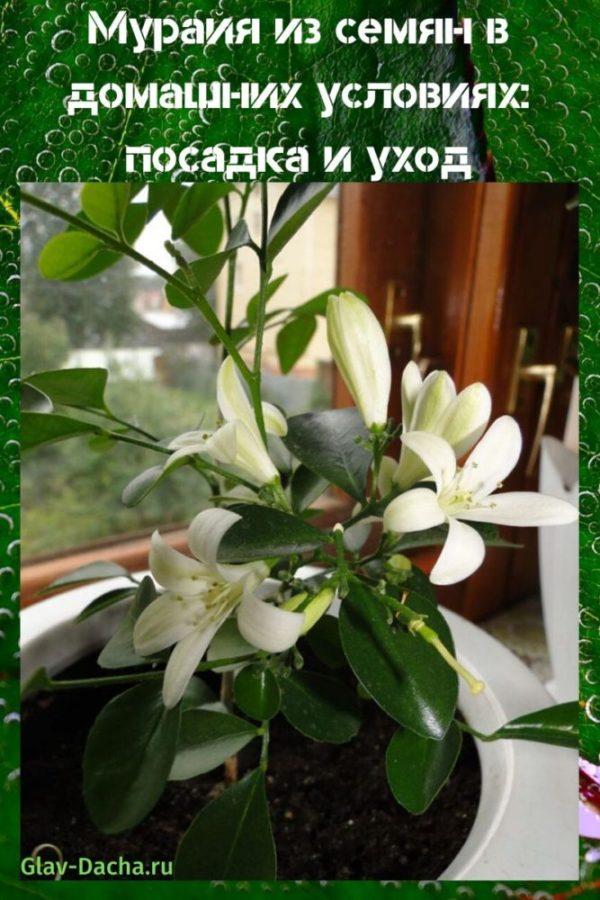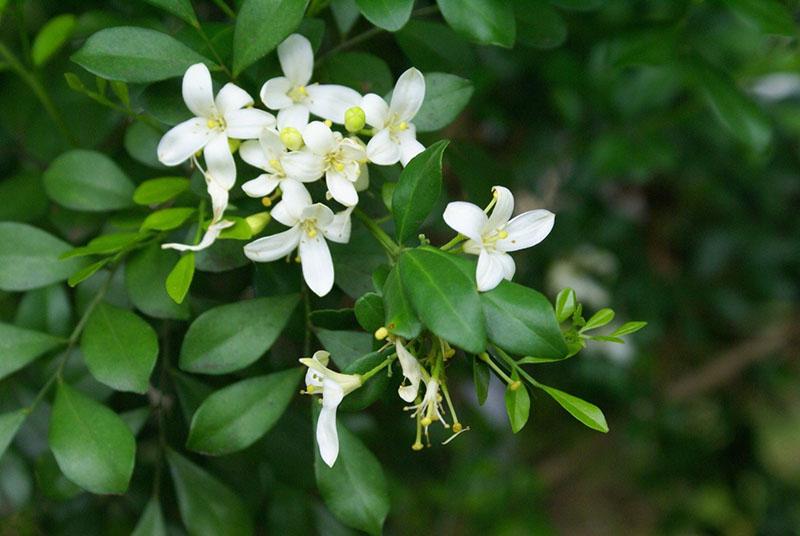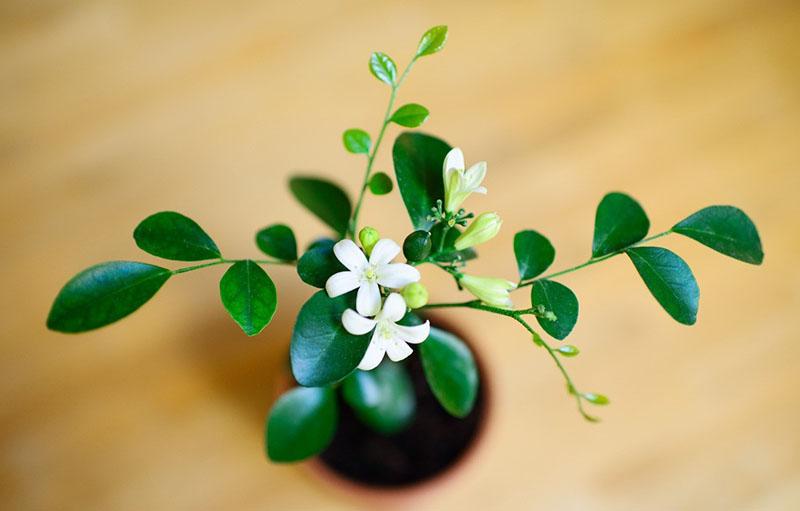Muraya from seeds at home: planting and care
 Muraya from seeds at home is a great option for eco-friendly home decoration. The plant tolerates artificial light well and has year-round flowering. Muraya flowers exude a pleasant aroma, the tree bears edible fruits and responds well to crown formation.
Muraya from seeds at home is a great option for eco-friendly home decoration. The plant tolerates artificial light well and has year-round flowering. Muraya flowers exude a pleasant aroma, the tree bears edible fruits and responds well to crown formation.
Features of the muraya plant

This attractive plant has the following characteristics:
- tree height from 30 to 150 cm;
- foliage is dark green, length from 1 to 10 cm;
- fragrant bloom throughout the year;
- flowers are small, white or light beige, fruits are black or red;
- edible, sweet berries;
- spreading, forming, crown;
- there is the ability to filter air in enclosed spaces;
- disinfects the air from micropathogens;
- self-pollinated culture.
 The plant tolerates temperature drops from +12 to +26 degrees Celsius well.
The plant tolerates temperature drops from +12 to +26 degrees Celsius well.
Muraya fruits can be used as food. They are not only safe for health, but also have a sweet, savory taste.
The most common plant variety is Murraya Paniculata from seeds for home cultivation.
Muraya seeds can be purchased at specialized gardening stores. Before buying, you need to pay attention to:
- manufacturer;
- shelf life (the less time is left before the expiration date, the lower the germination).
Also, seeds can be purchased from experienced gardeners immediately after ripening.
Features of the choice of substrate and pot
 When breeding muraya, the gardener needs to pay attention to the choice of soil and a suitable container for the future plant. Light soil with a neutral or slightly acidic environment is best.
When breeding muraya, the gardener needs to pay attention to the choice of soil and a suitable container for the future plant. Light soil with a neutral or slightly acidic environment is best.
For planting seeds, a mixture of:
- 2 pieces of leafy land;
- turf land 2 parts;
- 2 parts deciduous humus;
- 1 part coarse sand.
You can also purchase a ready-made citrus primer. The mixture is perfect for growing muraya. To improve seed germination and eliminate stagnation of liquid in the soil, baking powder can be added to the mixture, which can be coconut fiber, perlite, vermiculite.
Flower container
 To improve adaptation in a new place and germination of seeds, you need to choose the right pot.
To improve adaptation in a new place and germination of seeds, you need to choose the right pot.
Features of the container for the plant:
- A plastic cup or small decorative pot is suitable for germinating the seed.
- After the appearance of the first leaves, muraya can be transplanted into a larger pot, taking into account the growth of the root system. The free space in the pot should be no more than 1 cm from the walls of the container.
- There must be a drainage layer at the bottom of the pot and several holes for excess liquid to escape.
 Too large a pot size leads to a rapid increase in the volume of the root system at the expense of the growth of the ground part and flowering.
Too large a pot size leads to a rapid increase in the volume of the root system at the expense of the growth of the ground part and flowering.
When self-preparing a soil mixture for growing muraya from seeds at home, it is recommended to disinfect the substrate by calcining, steaming or a solution of potassium permanganate.
Thus, the development of pathogenic flora and seed death can be excluded.
Muraya from seeds at home
 Sowing muraya seeds is a painstaking but not complicated process. With the selection of healthy samples and the selection of suitable soil and capacity, the plant will sprout quickly.
Sowing muraya seeds is a painstaking but not complicated process. With the selection of healthy samples and the selection of suitable soil and capacity, the plant will sprout quickly.
Seed preparation
 Seed preparation is an important stage in planting muraya. Without carrying out detoxifying procedures, purchased material may die or infect other crops.
Seed preparation is an important stage in planting muraya. Without carrying out detoxifying procedures, purchased material may die or infect other crops.
Seed preparation stages:
- Place material in water for several hours.
- Soak in a solution of potassium permanganate orFitosporin»For 24 hours for disinfection.
- Treat with aloe juice or Epin solution to improve germination.
You can take a chance and plant seeds in the ground without additional preparation, but in this case, the effectiveness of garden work is significantly reduced.
Germination
 A homemade greenhouse is an excellent method of protecting and creating the right conditions for vulnerable home-grown muraya seeds.
A homemade greenhouse is an excellent method of protecting and creating the right conditions for vulnerable home-grown muraya seeds.
The greenhouse for murayi seedlings is a small container with a bottom lined with foam rubber. The substrate moistened with water in the container is an incubator, which must be arranged in a warm place protected from direct rays at a temperature of +24 to +35 degrees Celsius. On the 4th day of keeping the material in a homemade thermostat, the gardener can transplant sprouted seeds into a pot.
Green seeds are more germinating than beige or brown seeds. Brown color indicates the beginning of putrefactive processes, such materials are unsuitable for germination.
Planting in the ground and homemade greenhouses
 After the root appears, the seeds can be planted in the ground. Preliminary preparation allows you to identify empty material and exclude it from planting and significantly save resources for further germination.
After the root appears, the seeds can be planted in the ground. Preliminary preparation allows you to identify empty material and exclude it from planting and significantly save resources for further germination.
After choosing the hatched muraya, you need to:
- Take a disposable cup with a volume of up to 200 ml or a small pot, make a cross-shaped incision at the bottom, or burn several holes with a hot awl. Water should flow freely from the container.
- Line the bottom with a little drainage.
- Fill the container with the prepared citrus mixture or soil.
- Place the pot on a non-slotted pallet.
- Carefully plant the sprouted seed at a shallow depth, squeeze the ground around.
- Drizzle until the liquid comes out onto the pan.
- Install backlight.
- Cover with a dome to maintain moisture and temperature.
 Greenhouse conditions persist until shoots appear on the surface of the earth. To improve acclimatization, it is recommended to raise the dome by one third at night. You can remove the shelter 3 days after landing.
Greenhouse conditions persist until shoots appear on the surface of the earth. To improve acclimatization, it is recommended to raise the dome by one third at night. You can remove the shelter 3 days after landing.
After removing the shelter, you need:
- Water the flower, gently loosen the soil around the seed.
- Check if the top shell is interfering with the roots (up to 14 days).
- Remove the shell from the seed with tweezers.
- Spray the plant with water.
This stage of planting is not considered mandatory, but significantly improves the rate of development of the muraya.
After the fruits ripen, you can try to grow a new muraya from the seed. Planting immediately after ripening significantly increases the chances of rapid germination and adaptation of the plant.
Transplant
 Transplanting a young muraya into a new pot can be carried out annually. Increasing the space for the root system helps the flower grow, in addition, during transplantation, a complete or partial replacement of the soil occurs.
Transplanting a young muraya into a new pot can be carried out annually. Increasing the space for the root system helps the flower grow, in addition, during transplantation, a complete or partial replacement of the soil occurs.
Transplant features:
- The procedure is carried out in the spring.
- The diameter of the new pot should not exceed the dimensions of the old container by more than 1 centimeter on each side.
- Falling asleep of the neck of the flower is not allowed deeper than 3-5 cm.
- An adult plant needs to be transplanted no earlier than 3 years later. Instead, the grower needs to replace the topsoil.
After transplanting, the plant must be placed in a shaded area and watered thoroughly.
Easy-care muraya from seeds at home
Muraya belongs to demanding plants, but responds with gratitude and rich flowering to the care of the gardener. After transplanting into a pot, you need to create permanent conditions suitable for the growth and development of color.
Lighting
 For each period of the plant's life at home, it is necessary to choose the optimal lighting.
For each period of the plant's life at home, it is necessary to choose the optimal lighting.
Lighting Features:
- After removing the dome, an 11W lamp at a distance of 10 cm from the flower is suitable to illuminate the plant.
- An adult plant is well suited for diffused light at a distance of 60 cm from a window on the east or west side.
- Artificial lighting should simulate the change of day and night (at least 12-14 hours of "light").
- Some murayi varieties require a particularly long day of light - 16 hours.
- Short periods of sunshine during the dark season should be supplemented with artificial lighting.
Muraya is a shade-loving plant, from the direct light of which a whitish tint appears on the surface of the leaves. It is especially difficult for a plant to endure abrupt changes and removal from artificial light under aggressive direct rays.
In insufficient light, the flower begins to shed its leaves. To eliminate this problem, you can rearrange the pot closer to the window or increase the intensity and duration of the artificial "day".
Pruning
 To stimulate ground growth, plants should be pruned and trimmed gradually in spring or summer. The peculiarities of muraya are the constant formation of flowers, therefore, waiting for a moment for a haircut after all the fruits ripen will not work.
To stimulate ground growth, plants should be pruned and trimmed gradually in spring or summer. The peculiarities of muraya are the constant formation of flowers, therefore, waiting for a moment for a haircut after all the fruits ripen will not work.
Permanent elements of care include the timely removal of drying branches and flower leaves.
Top dressing
Until the height of the shoots reaches 15 cm, the flower does not need feeding, when the plant is fully strengthened, you can start adding solutions for citrus crops.
Suitable for feeding muraya:
- "Flower Happiness" for citrus fruits;
- organic fertilizers "Izumrud";
- macro-microelements "Growth".
The best time to start feeding is 2-3 months after transplanting into a new pot. Fertilization - no more than 1 time per month.
Watering and air humidity
 Muraya needs constant, abundant watering and daily spraying of the leaves in the evening. Drainage and holes in the bottom of the pot help to eliminate stagnant moisture in the soil, however, waterlogging and stagnation of liquid in the pan should also be avoided. Before watering and spraying, the water must be defended; during the heating season, the flower needs more moisture than in other seasons.
Muraya needs constant, abundant watering and daily spraying of the leaves in the evening. Drainage and holes in the bottom of the pot help to eliminate stagnant moisture in the soil, however, waterlogging and stagnation of liquid in the pan should also be avoided. Before watering and spraying, the water must be defended; during the heating season, the flower needs more moisture than in other seasons.